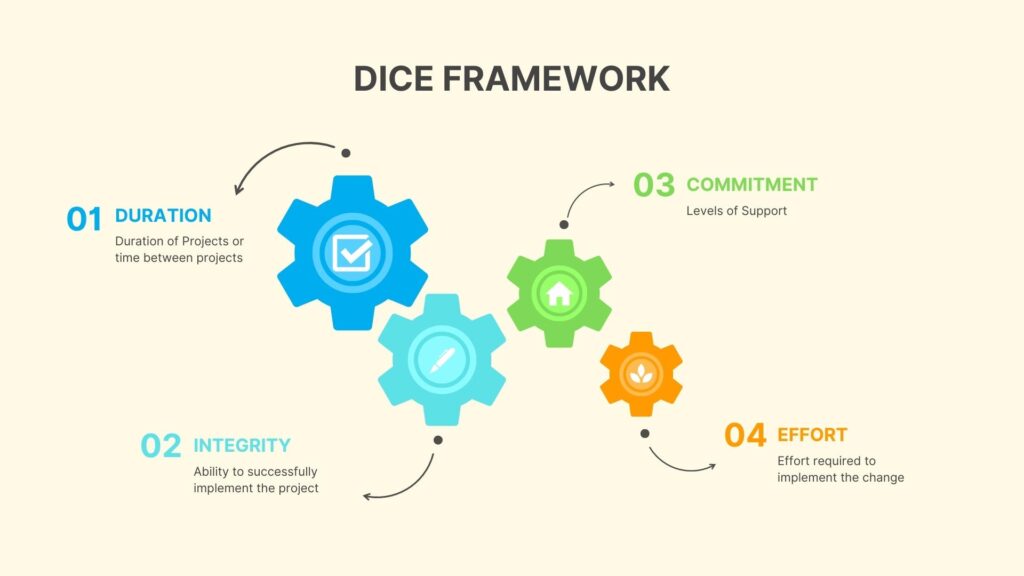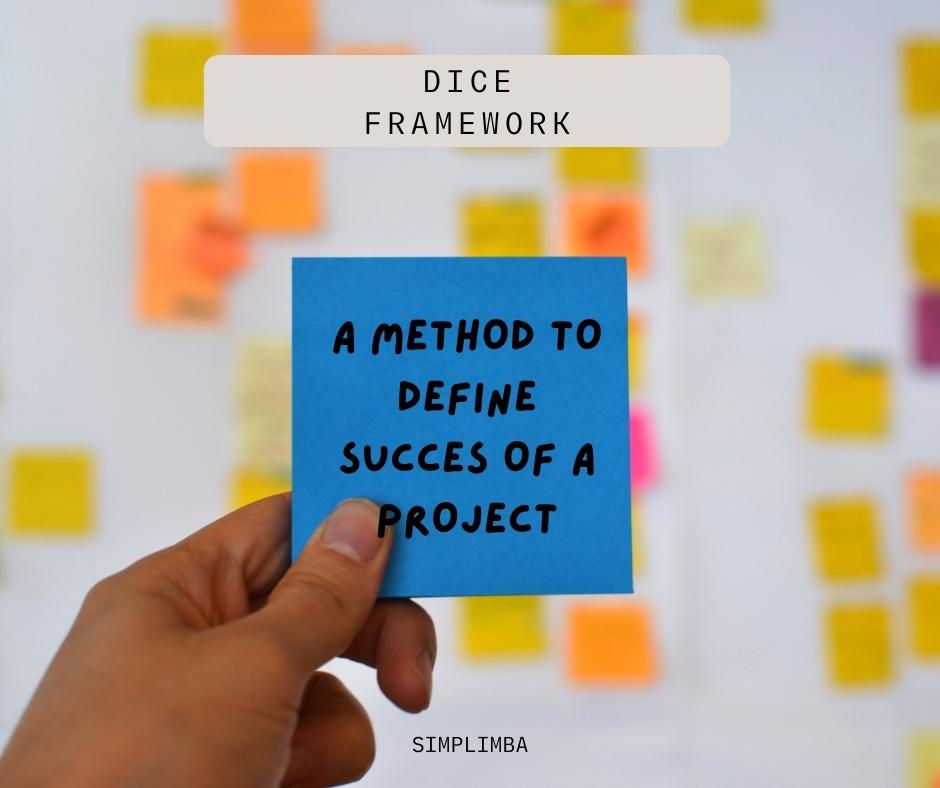DICE is an acronym for duration, integrity, cost, and engagement. It was created by Perry Keene, Kathleen Conlon, and Alan Jackson. It is designed to help teams work together on complex problems. It is a collaborative model that uses a set of rules to guide work. Typically, each team member contributes one or more criteria.

Duration
The DICE Framework is a method of assessing the success of a project. It is a scoring system that includes four factors: project team performance, timeliness, risk, and integrity. The result is a mathematical score that measures the likelihood of project success. A positive score indicates a project will be successful. A score that is neutral or negative indicates that the project may need to be altered.
The DICE framework can help companies to evaluate the success of a change initiative. The calculated score can be compared to those of previous projects. This can help organizations determine whether the current project is on track and is achieving its goals. In addition, it can help executives gauge the amount of work necessary to make a project successful.
The DICE Framework is based on research by the Boston Consulting Group. They studied over 225 companies and found a clear connection between the success and failure of change projects. Each factor must be assigned a score between one and four. The higher the score, the greater the chance of success. This framework also helps organizations assess risks.
Using the DICE framework helps organizations measure the level of commitment to a project. The DICE score is calculated from a formula based on values assigned to each component. The DICE framework also considers the commitment of stakeholders, senior management, and sponsors. If the total score is less than seven, an initiative is likely to be successful, while a project that has a score between fourteen and seventeen is in the Worry Zone.
In large change programs, companies often initiate a number of projects at the same time. However, senior management must be careful to not make the projects compete for resources. They may also prioritize certain projects based on personal preference, resulting in the failure of some projects. It is critical to identify the projects that will be problematic later on and ensure they are dealt with appropriately. The DICE framework helps managers identify these projects and ensure that they do not waste time and resources on them.
Integrity
The DICE framework is a methodology for project teams to evaluate their performance using the DICE factors. The framework provides a consistent and independent review of projects. The DICE factors have four areas of evaluation: risk, impact, implementation, and integrity. These areas measure project performance based on their likelihood of success.
The DICE framework enables leaders to better predict project outcomes and allocate resources strategically. This allows them to maximize the delivery of the program or portfolio of initiatives. It is especially useful for change programs and strategic initiatives. For example, a DICE-based approach to project management can help senior leaders understand the workload issues of common employees and identify project commitment needs.
The DICE Framework is not without limitations. For example, DICE score can differ from team member to team member. Even the same manager can score differently depending on the time of the day, or external influences. Creating a reproducible process for DICE scoring is a challenge. However, it can be helpful in evaluating risk and improving project performance.
In addition to analyzing risk, the DICE framework helps companies assess the success of change initiatives. A DICE chart can be created that maps past projects’ scores. This allows companies to see which change initiatives are successful and which ones are not. This chart can also be used to compare current project scores to previous projects.
Cost
The DICE framework can be used in both large and small organizations. It is based on four elements. Each element has a score from one to four. A score of one indicates that it will positively contribute to success, while a score of four means it will have no contribution to success. Organizations should use this framework to measure the performance of their projects.
Companies can measure the results of a change initiative using the DICE framework. Many organizations use it before launching a transformation program. The tool allows executives to compare their score to previous results to see how successful their efforts are. In addition, each score must be balanced against a portfolio or trajectory of scores.
The DICE framework is easy to use. However, it has several limitations. For one, it is not a universal solution. Different managers will score differently on it. Even the same manager can score differently depending on the time of year or external personal influences. This makes it difficult to reproduce the results across different management teams.
The DICE framework helps companies identify and address problems quickly. It helps project managers track the progress of multiple projects, manage portfolios of projects, and force the right conversations. By targeting potential issues early, DICE helps organizations avoid costly mistakes. The DICE score is an important indicator of the success or failure of a project.
The DICE framework uses the economic model. This approach assumes that policy makers who negotiated the Copenhagen temperature target have different damage functions.
Joint engagement of managers and developers

A key challenge in software development is introducing change. During large change programs, companies often initiate numerous projects. It is vital for senior management to manage these projects carefully and not let them compete for resources. For example, managers might allocate their best employees to sponsored projects while giving high attention to favored personal projects. To overcome this challenge, companies can use the DICE framework to identify which projects have the potential to cause problems later on.
The DICE framework helps organizations calculate the amount of additional work that will be needed to implement change initiatives. It also helps assess the success of change initiatives. By calculating how much additional work is needed to implement a change, project teams can assess the benefits and risks. A common rule of thumb is that workloads should not increase more than 10%.
The DICE Framework was developed by Boston Consulting Group partners. It first appeared in the Harvard Business Review and was later republished in HBR’s On Point magazine. It was also named one of HBR’s 10 Must-Reads on Change Management. It received a patent in 2014. The framework enables leaders to manage resources and handle project issues in a tactful manner.
Ease of implementation
The DICE framework, developed by Boston Consulting Group, is a strategic project management method that helps organizations pay attention to the right things and avoid wasting time. The DICE model highlights four critical hard and soft change elements that need to be addressed when an organization is implementing a change initiative. These elements help senior leaders ensure that they are not wasting time on things that don’t matter.
The DICE simulation approach retains the strengths of the Markov model, but also removes a number of Markov modeling constraints. The user interface remains spreadsheet-based, which ensures ease of use. The DICE framework also features a richer set of features than traditional Markov models, including improved transparency and easy implementation.
The DICE model also allows the user to store a range of values for each input parameter. This makes it possible for the user to choose the right value based on the conditions that are associated with the parameter. It also provides the user with the option to run probabilistic sensitivity analyses.
Another key benefit of the DICE framework is that it can help organizations calculate the amount of work that will be required to implement a change initiative. This means companies can better assess the success or failure of their changes. A DICE framework also makes it possible to gauge the level of risk associated with a change initiative.
DICE Calculations
Formula for calculation of DICE
D + (2 x I) + (2 x C1) + C2 + E
The Hard Side of Change Management, HBR
Duration
- < 2 months = 1
- 2-4 months = 2
- 4-8 months = 3
- > 8 months = 4
Team Performance Integrity
- Very good = 1
- Good = 2
- Average = 3
- Poor = 4
Commitment (Senior Management)
- Clearly and strongly communicate the need = 1
- Seem to want success = 2
- Neutral = 3
- Reluctant = 4
Commitment (Local)
- Eager = 1
- Willing = 2
- Reluctant = 3
- Strongly Reluctant = 4
Effort
- < 10% additional = 1
- 10-20% additional = 2
- 20-40% additional = 3
- > 40 % additional = 4
Samrat is a Delhi-based MBA from the Indian Institute of Management. He is a Strategy, AI, and Marketing Enthusiast and passionately writes about core and emerging topics in Management studies. Reach out to his LinkedIn for a discussion or follow his Quora Page
